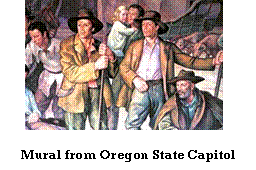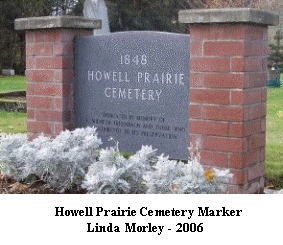
George Fristo McCorkle - Oregon Pioneer
George Fristo
McCorkle was the son of Alexander and Rebecca Elizabeth Fristo McCorkle and the
great grandson of Samuel and Sarah Buchanan McCorkle of Augusta County,
Virginia. Alexander and Elizabeth were married in 1818 in Christian County,
Kentucky and George was born about a year latter. George's grand parents,
John and Lydia Forrest McCorkle moved from to Green County, Kentucky about 1800
and John was killed by renegades in 1814. John’s widow, Lydia, soon moved to
Missouri with her thirteen children. In 1855, Alexander died in Buchanan County,
Missouri 1855 leaving a will.
What little is known about the early days of
the Alexander McCorkle family in M issouri comes from the short
biography of George’s brother Nelson McCorkle which was
published in 1883. The family first lived in Cooper County, but
soon moved to
Clay County and then finally to Buchanan County in 1833. It was in Buchanan that
George probably met Elizabeth Howell whom he married February 6, 1840. Elizabeth
was born in Tennessee and was the daughter of John and Temperance Howell. Howell
family tradition relates that John traveled to Oregon in 1837 as a member of a
surveying team. Upon his return to Missouri, his experiences must have had a
very positive impact on the community since, in 1843, George, Elizabeth and
their infant daughter Temperance McCorkle joined John Howell, his family and several
other Buchanan County residents on the perilous two thousand mile journey to the
Oregon Country.
issouri comes from the short
biography of George’s brother Nelson McCorkle which was
published in 1883. The family first lived in Cooper County, but
soon moved to
Clay County and then finally to Buchanan County in 1833. It was in Buchanan that
George probably met Elizabeth Howell whom he married February 6, 1840. Elizabeth
was born in Tennessee and was the daughter of John and Temperance Howell. Howell
family tradition relates that John traveled to Oregon in 1837 as a member of a
surveying team. Upon his return to Missouri, his experiences must have had a
very positive impact on the community since, in 1843, George, Elizabeth and
their infant daughter Temperance McCorkle joined John Howell, his family and several
other Buchanan County residents on the perilous two thousand mile journey to the
Oregon Country.
Some forty
years before, Meriwether Lewis and William Clark had been commissioned by
President Thomas Jefferson to explore a route to the Pacific Ocean. Their
journey to Oregon from St. Louis took almost a year and a half to complete and
is considered by many to be one of the greatest exploratory adventures in
history. In the next four decades, many adventurers, fur traders,
frontiersman and missionaries had made their way to the Pacific Northwest by
land and by sea, but 1842 marks the beginning of the first large wagon
immigration involving families. In that year, some 130 individuals made the long
journey. The next year, four large contingents totaling some one thousand people
left Independence Missouri for Oregon. These events occurred before Great
Britain and United States had agreed on a common Oregon Country border at the 49th
parallel in 1846. Oregon became a U. S. Territory in 1848 and 33rd
state in 1859.
Many of the
guides that were hired by the travelers were ex-mountain men, hunters and
trappers that had
 already
been west. Most of the families traveled with modified farm wagons called
Prairie Schooners which were usually pulled by oxen. Because the trip cost
nearly one thousand dollars, it took an average family three to five years to
accumulate the funds to make the trip. Many families also took milk cows, horses
and cattle. The modern “Western” movie has over dramatized and greatly
exaggerated the danger presented by Indians. Far more dangerous for the early
travelers was disease, primarily cholera. Probably more people were
drowned in rivers crossings than were killed by Indians. Numerous others were
killed and injured by being run over by wagon
already
been west. Most of the families traveled with modified farm wagons called
Prairie Schooners which were usually pulled by oxen. Because the trip cost
nearly one thousand dollars, it took an average family three to five years to
accumulate the funds to make the trip. Many families also took milk cows, horses
and cattle. The modern “Western” movie has over dramatized and greatly
exaggerated the danger presented by Indians. Far more dangerous for the early
travelers was disease, primarily cholera. Probably more people were
drowned in rivers crossings than were killed by Indians. Numerous others were
killed and injured by being run over by wagon wheels, trampled in livestock stampedes and accidental shootings. The mortality
rate for the trip has been estimated to be about five percent. One of every 17
adults died making the trip and one of every five children was buried beside the
trail. Extended bad weather was another serious concern. Heavy rain and
accompanying mud could slow the wagon train from oxen to snail’s pace. Delays
increased the probability that the travelers would not make it across the Oregon
mountains
by winter’s snowfall.
wheels, trampled in livestock stampedes and accidental shootings. The mortality
rate for the trip has been estimated to be about five percent. One of every 17
adults died making the trip and one of every five children was buried beside the
trail. Extended bad weather was another serious concern. Heavy rain and
accompanying mud could slow the wagon train from oxen to snail’s pace. Delays
increased the probability that the travelers would not make it across the Oregon
mountains
by winter’s snowfall.
On May 22, 1843, the Oregon Emigrating Company of some 700/800
men, women and children and 100 Prairie Schooners embarked from Independence.
Many in the company brought rather large herds of cattle. John Gantt, a mountain
man, was engaged to guide the train to Fort Hall and Dr. Marcus Whitman, a
missionary returning to Oregon, also accompanied the
company. In addition to their personal belongings and livestock the travelers
were advised to bring 150 pounds of flour, 15 pounds of coffee, 25 pounds of
bacon, 25 pounds of sugar, a quantity of yeast for bread making, salt and
pepper. At the Kansas River ford, Peter Burnett and James Nesmith were elected
Captain and Orderly Sergeant. Later on, however, severe friction developed
between the cattle owners and the non-cattle owners. This resulted in the
company being split into two groups: Jesse Applegate was elected Captain of the
cow contingent and William Martin lead the column without cattle. During the
most trying times, Dr. Whitman seems to have been a very steadying influence.
The average progress for a day was about fifteen miles. Several of the party
kept diaries and others recorded their recollections later. Stephenie Flora has
integrated these sources and compiled a day-to-day account of the journey. This
interesting chronology may be viewed at The Emigration to the Oregon
Country in 1843. The young George McCorkle, his infant daughter Temperance
and his father-in-law John Howell are mentioned as members of the 1843 company
in some of these accounts, but very little more is recorded about them.
The Oregon Trail and Calendar of the 1843 Oregon Emigrating Company
End of the Oregon Trail Interpretive Center - Historical Maps

May 22 - Left Independence Missouri
July 14 - Fort Laramie
August 6 – Crossed the Continental Divide
August 14 - Fort Bridger
August 27 –Fort Hall
September 20 – Fort Boise
October 5 – Crossed the Oregon Blue Mountains
October 10 – Dr. Whitman’s Mission
October 16 – Fort Walla Walla
November 20 – Arrived Oregon City, Oregon
In 1845, John Howell and his large family were enumerated in
Champoeg District as part of the Oregon Territorial Census. At that time George
and Elizabeth were probably living with the Howells, but in the 1849 census of
the same district, the McCorkles were listed. Later in 1849, Champoeg was
renamed Marion County and on January 23, 1850, George, Elizabeth and five
children were enumerated. Two homes away were John and Frances Howell and
family. On July 9, 1860, the McCorkle family was enumerated in Howell Prairie,
Marion County. Their post office was listed as Silverton. Nearby were Jno and
Francis Howell. Howell Prairie was named for John Howell and is west of
Silverton between the branches Pudding River.
Although Ge orge
McCorkle must have claimed land shortly after arriving in Oregon, this property
was not patented until March 19, 1866, when George F. and Elizabeth F. McCorkle
patented 639.77 contiguous acres in Marion County. This land is in Range 2 West,
Township 6 South, Sections 25, 26, 35 & 36 and Township 7 South, Section 2. The
patent was free under the terms of the 1850 Oregon-Donation Act passed by
Congress to encourage the settlement of Oregon after statehood was granted. The
location of this property is now called North Howell and is about six miles west
of Silverton. On the left is an engraving of the McCorkle home from the
1878 Atlas of of Marion & Linn Counties, Oregon, published by Edgar Williams
& Co., San Francisco, California.
orge
McCorkle must have claimed land shortly after arriving in Oregon, this property
was not patented until March 19, 1866, when George F. and Elizabeth F. McCorkle
patented 639.77 contiguous acres in Marion County. This land is in Range 2 West,
Township 6 South, Sections 25, 26, 35 & 36 and Township 7 South, Section 2. The
patent was free under the terms of the 1850 Oregon-Donation Act passed by
Congress to encourage the settlement of Oregon after statehood was granted. The
location of this property is now called North Howell and is about six miles west
of Silverton. On the left is an engraving of the McCorkle home from the
1878 Atlas of of Marion & Linn Counties, Oregon, published by Edgar Williams
& Co., San Francisco, California.
On the right is a 1914 photo of the McCorkle home from the Oregon Historic Photo
Collection. We do not know the history of this home; however, the resemblance to
the above engraving is remarkable. We welcome any other information concerning
this home.
Oregon Historic Photo
Collection. We do not know the history of this home; however, the resemblance to
the above engraving is remarkable. We welcome any other information concerning
this home.
In 1848,
Temperance, the 1st
wife of John Howell died and was buried near the Howell home. This was the start
the Howell Prairie Cemetery. When John Howell died in 1869, James Murphy
purchased some of the Howell estate, but controversy arose over the status of
the cemetery. To settle this problem, Alexander, son of George McCorkle and
son-in-law of James Murphy purchased the cemetery land for $30 and recorded the
deed as a permanent cemetery. George F. and Elizabeth Howell McCorkle are also
buried here.
Thanks to the
research of Linda Morley, we can add some contemporary photos to this narrative.
Even though it has been altered at some time, the George F. McCorkle House,
located at 8474 Hazel Green Road in Silverton, was placed on the Oregon
Historical Register in 1974. The date of construction was ca. 1851.
If the reader
can add anything to this narrative, please contact me at my email address below.


Bibliography
Bureau of Land
Management – General Land Office Records
Eddins, O. Ned
Historical Facts of the Oregon Trail and America's Manifest Destiny
End of the Oregon Trail Resources
Flora, Stephenie Emigrants to
Oregon in 1843
Flora, Stephenie The
Emigration to the Oregon Country in 1843
Munkres, Dr. Robert L.
Oregon-California Trails Association, Trail Facts
Oregon Historic Photograph Collections
Oregon Native Son and Historical Magazine Vol. 2, No. 6. Native Son
Publishing Co., Portland, Oregon, 1900
Oregon State
Archives
Pioneer History – Churches of Christ & Christian Churches in the Pacific
Northwest
Portrait and Biographical Record, Buchanan and Clinton Counties, Missouri,
containing Biographical Sketches of Prominent and Representative Citizens,
together with Biographies and Portraits of all the Presidents of the United
States. Chapman Bros., Chicago, 1883
Click here to email me. Your comments, additions & corrections are welcomed.
Back to McCorkle Home Page
Revised Sep 4, 2012